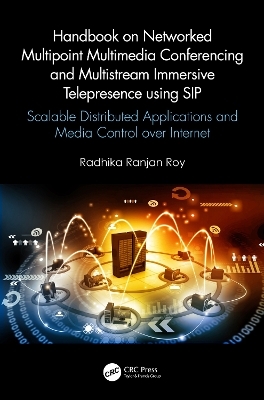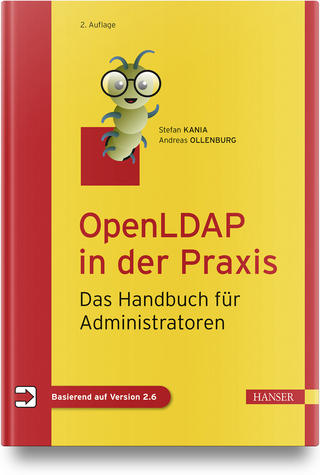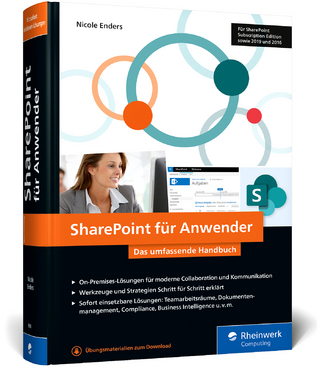
Handbook on Networked Multipoint Multimedia Conferencing and Multistream Immersive Telepresence using SIP
CRC Press (Verlag)
978-0-367-61671-7 (ISBN)
This book includes mandatory and optional texts of all standards in a chronological and systematic way almost with one-to-one integrity from the beginning to end, allowing the reader to understand all aspects of the highly complex real-time applications.
It is a book that network designers, software developers, product manufacturers, implementers, interoperability testers, professionals, professors, and researchers will find to be immensely useful. Practitioners and engineers in all spectrums who are concentrating on building the real-time, scalable, interoperable multipoint applications, can use this book to make informed choices based on technical standards in the market place, on all proprietary non-scalable and non-interposable products. This book will provide focus and foundation for these decision makers.
Radhika Ranjan Roy has been an electronics engineer, United States Army Research, United States Command, Control, Communications, Computers, Combat Systems, Intelligence, Surveillance, and Reconnaissance (C5ISR)-S&TCD Laboratories (previously known as CERDEC), Aberdeen Proving Ground (APG), Maryland, United States since 2009. Dr. Roy is leading research and development efforts in the development of scalable large-scale SIP-based VoIP/Multimedia networks and services, cybersecurity, artificial intelligence and machine/deep learning (AI/ML/DL) architecture, mobile ad hoc networks (MANETs), Peer-to-Peer (P2P) networks, cybersecurity detecting application software and network vulnerability, jamming detection, supporting an array of the Army/ Department of Defense’s Nationwide and Worldwide Warfighter Networking Architectures and participating in technical standards development in Multimedia/Real-Time Services Collaboration, IPv6, Radio Communications, Enterprise Services Management, and Information Transfer of Department of Defense (DoD) Technical Working Groups (TWGs). He received his PhD in Electrical Engineering with Major in Computer Communications from the City University of New York (CUNY), NY, United States in 1984 and his MS in Electrical Engineering from the Northeastern University, Boston, MA, United States in 1978. He received his BS in Electrical Engineering from the Bangladesh University of Engineering & Technology (BUET), Dhaka, Bangladesh in 1967. He was born in the renowned country town of Derai, Bangladesh. Prior to joining CERDEC, Dr. Roy worked as the lead system engineer at CACI, Eatontown, NJ from 2007 to 2009 and developed Army Technical Resource Model (TRM), Army Enterprise Architecture (AEA), DoD Architecture Framework (DoDAF), and Army LandWarNet (LWN) Capability Sets, and technical standards for Joint Tactical Radio System (JTRS), Mobile IPv6, MANET, and SIP, supporting Army Chief Information Officer (CIO)/G-6. Dr. Roy worked as senior system engineer, SAIC, Abingdon, MD from 2004 to 2007, supporting Modeling, Simulations, Architectures, and System Engineering of many Army projects: WIN-T, FCS, and JNN. During his career, Dr. Roy worked in AT&T/Bell Laboratories, Middletown, NJ as senior consultant from 1990 to 2004 and led a team of engineers in designing AT&T’s Worldwide SIP-based VoIP/Multimedia Communications Network Architecture, consisting of wired and wireless, from the preparation of Request for Information (RFI) to the evaluation of vendor RFI responses and interactions with all selected major vendors related to their products. He participated in and contributed to the development of VoIP/H.323/SIP multimedia standards in ITU-T, IETF, ATM, and Frame Relay standard organizations. Dr. Roy worked as senior principal engineer in CSC, Falls Church, VA from 1984 to 1990 and worked in the design and performance analysis of the US Treasury nationwide X.25 packet-switching network. In addition, he designed many network architectures of many proposed U.S. Government and Commercial Worldwide and Nationwide Networks: Department of State Telecommunications Network (DOSTN), U.S. Secret Service Satellite Network, Veteran Communications Network, and Ford Company’s Dealership Network. Prior to CSC, he worked from 1967 to 1977 as deputy director, Design, in PDP, Dhaka, Bangladesh. Dr. Roy’s research interests include the areas of artificial intelligence, machine/deep learning, blockchain cloud and fog computing, mobile ad hoc networks, multimedia communications, peer-topeer networking, and quality-of-service. He has published over 60 technical papers and is holding or pending over 35 patents. He also participates in many IETF working groups. Dr. Roy authored three books Handbook on SDP for Multimedia Session Negotiations: SIP and WebRTC Telephony (CRC Press/Taylor & Francis, 2018), Handbook on Session Initiation Protocol: Networked Multimedia Communications for IP Telephony (CRC Press/Taylor & Francis, 2016), and Handbook of Mobile Ad Hoc Networks for Mobility Models, Springer, 2010. He lives in the historical district of Howell Township, New Jersy, with his wife Jharna.
Contents
Preface...........................................................................................................................................xxxi
Author...........................................................................................................................................xxxv
Chapter 1 Scalable Networked Multipoint Multimedia Conferencing and Telepresence..............1
1.1 Networked Multipoint Multimedia Conferencing..............................................1
1.2 Basic Conferencing Protocol Architecture.........................................................4
1.3 Third-Party Multiparty Conferencing.............................................................. 12
1.4 Multistream Immersive Telepresence...............................................................23
1.5 Scalable Centralized Multipoint Multimedia Conferencing Systems
and Protocols Framework.................................................................................24
1.6 Terminology.....................................................................................................28
1.7 Summary..........................................................................................................28
1.8 Problems........................................................................................................... 41
References................................................................................................................... 42
Chapter 2 Centralized Conferencing System Architecture......................................................... 43
2.1 Introduction...................................................................................................... 43
2.2 Convention........................................................................................................ 43
2.3 Terminology..................................................................................................... 43
2.4 Overview..........................................................................................................44
2.5 Centralized Conferencing Data........................................................................ 45
2.6 Centralized Conferencing Constructs and Identifiers...................................... 47
2.7 Conferencing System Realization....................................................................50
2.8 Conferencing Mechanisms............................................................................... 55
2.9 Conference Scenario Realizations....................................................................56
2.10 Relationships between SIP and Centralized Conferencing System
Frameworks......................................................................................................69
2.11 Security Considerations....................................................................................69
2.12 Summary.......................................................................................................... 71
2.13 Problems........................................................................................................... 72
Chapter 3 Media Server Control Architecture............................................................................. 73
3.1 Introduction...................................................................................................... 73
3.2 Terminology..................................................................................................... 75
3.3 Architecture Overview..................................................................................... 75
3.4 NSIP Usage.......................................................................................................77
3.5 Media Control for IVR Services...................................................................... 78
3.6 Media Control for Conferencing Services........................................................80
3.7 Security Considerations....................................................................................85
3.8 Summary..........................................................................................................86
3.9 Problems...........................................................................................................87
Chapter 4 Conferencing Information Data Model for Centralized Conferencing.......................89
4.1 Introduction......................................................................................................89
4.2 Terminology.....................................................................................................89
4.3 Overview..........................................................................................................89
Comparison.......................................................................... 91
4.4 Data Model Definition......................................................................................92
4.5 RELAX NG Schema...................................................................................... 103
4.6 XML Schema Extensibility............................................................................ 103
4.7 XML Example................................................................................................ 103
4.8 Non-Normative RELAX NG Schema in XML Syntax (Appendix A of
RFC 6501)....................................................................................................... 103
4.9 Relax Schema in XML Syntax (Appendix B of RFC 6501).......................... 103
4.10 Security Considerations.................................................................................. 104
4.11 Summary........................................................................................................ 108
4.12 Problems......................................................................................................... 109
References................................................................................................................. 111
Chapter 5 Centralized Conferencing Manipulation Protocol.................................................... 129
5.1 Introduction.................................................................................................... 129
5.2 Conventions and Terminology........................................................................ 129
5.3 XCON Conference Control System Architecture.......................................... 129
5.4 Protocol Overview.......................................................................................... 131
5.5 CCMP Messages............................................................................................ 134
5.6 Example of CCMP in Action......................................................................... 153
5.7 Locating a Conference Server........................................................................ 162
5.8 Managing Notifications.................................................................................. 163
5.9 HTTP Transport............................................................................................. 165
5.10 Security Considerations.................................................................................. 166
5.11 XML Schema................................................................................................. 168
5.12 IANA Considerations..................................................................................... 169
5.13 Summary........................................................................................................ 176
5.14 Evaluation of Other Protocol Models and Transports Considered for
CCMP (Appendix A of RFC 6503)................................................................ 176
5.15 Problems......................................................................................................... 178
References................................................................................................................. 179
Chapter 6 Binary Floor Control Protocol.................................................................................. 181
6.1 Introduction.................................................................................................... 181
6.2 Terminology................................................................................................... 181
6.3 Scope.............................................................................................................. 181
6.4 Overview of Operation................................................................................... 183
6.5 Packet Format................................................................................................. 186
6.6 Transport........................................................................................................200
6.7 Lower-Layer Security..................................................................................... 201
6.8 Protocol Transactions..................................................................................... 201
6.9 Authentication and Authorization..................................................................202
6.10 Floor Participant Operations..........................................................................202
6.11 Chair Operations............................................................................................205
6.12.1 Requesting Information about Floors...............................................206
6.13 Floor Control Server Operations....................................................................208
6.14 Security Considerations.................................................................................. 214
6.15 BFCP Connection Establishment................................................................... 215
6.16 IANA Considerations..................................................................................... 218
6.17 Summary........................................................................................................ 221
6.18 Problems.........................................................................................................222
Chapter 7 XCON Notification Service.......................................................................................225
7.1 Introduction....................................................................................................225
7.2 Terminology...................................................................................................225
7.3 Notification Formats.......................................................................................225
7.4 Full Notifications............................................................................................225
7.5 Partial Notifications........................................................................................227
7.6 IANA Considerations.....................................................................................229
7.7 Security Considerations..................................................................................229
7.7.1 Connection Security..........................................................................230
7.7.2 Authorization Considerations ...........................................................230
7.8 Summary........................................................................................................230
7.9 Problems......................................................................................................... 231
Reference................................................................................................................... 231
Chapter 8 Media Channel Control Framework.......................................................................... 233
8.1 Introduction.................................................................................................... 233
8.2 CFW Capabilities........................................................................................... 233
8.3 Overview........................................................................................................ 235
8.4 Control Channel Setup................................................................................... 238
8.4.1 Control Client SIP UAC Behavior..................................................... 238
8.4.2 Control Server SIP UAS Behavior.................................................... 239
8.5 Establishing Media Streams – Control Client SIP UAC Behavior.................240
8.6 Control Framework Interactions..................................................................... 241
8.7 Response Code Descriptions.......................................................................... 247
8.8 Control Packages............................................................................................ 247
8.9 Formal Syntax................................................................................................249
8.10 Examples........................................................................................................ 251
8.11 Extensibility....................................................................................................254
8.12 Security Considerations..................................................................................254
8.12.1 Session Establishment.......................................................................254
8.13 IANA Considerations.....................................................................................256
8.14 Common Package Components (Appendix A of RFC 6230).........................256
8.15 Summary........................................................................................................ 257
8.16 Problems......................................................................................................... 257
Chapter 9 Mixer Package for Media Control Channel Framework........................................... 259
9.1 Introduction.................................................................................................... 259
9.2 Conventions and Terminology........................................................................260
9.3 Control Package Definition............................................................................260
9.4 Element Definitions........................................................................................ 262
9.5 Formal Syntax................................................................................................290
9.6 Examples........................................................................................................ 291
9.6.1 AS-MS Framework Interaction Examples........................................ 291
9.6.1.1 Creating a Conference Mixer and Joining a
Participant..........................................................................309
9.6.1.2 Receiving Active Talker Notifications...............................309
9.6.1.3 Conference Termination....................................................309
9.6.2 Mixing Examples.............................................................................. 310
9.6.2.1 Audio Conferencing........................................................... 310
9.6.2.2 Bridging Connections........................................................ 312
xvi Contents
9.6.2.3 Video Conferencing........................................................... 312
9.7 Security Considerations.................................................................................. 313
9.8 IANA Considerations..................................................................................... 315
9.9 Summary........................................................................................................ 315
9.10 Problems......................................................................................................... 315
References................................................................................................................. 316
Chapter 10 Media Session Recording.......................................................................................... 317
10.1 Use Cases and Requirements for SIP-Based Media Recording................... 317
10.2 Media Recording Architecture....................................................................324
10.3 Media Recording Metadata.......................................................................... 331
XML Body.................................................................344
10.3.9 XML Schema Definition for Recording Metadata....................... 345
10.3.10 Security Considerations................................................................348
10.3.11 IANA Considerations...................................................................349
10.4 Media Session Recoding Protocol...............................................................349
10.5 Summary...................................................................................................... 371
10.6 Problems....................................................................................................... 372
References................................................................................................................. 373
Chapter 11 Media Resource Brokering....................................................................................... 375
11.1 Introduction.................................................................................................. 375
11.2 Conventions and Terminology..................................................................... 375
11.3 Problem Discussion...................................................................................... 377
11.4 Deployment Scenario Options..................................................................... 378
11.5 MRB Interface Definitions.......................................................................... 381
11.6 MRB Acting as a B2BUA............................................................................405
11.7 Multimodal MRB Implementations.............................................................405
11.8 Relative Merits of Query Mode, IAMM, and IUMM.................................406
11.9 Examples......................................................................................................407
11.10 Media Service Resource Publisher Interface XML Schema....................... 425
11.11 Media Service Resource Consumer Interface XML Schema......................444
11.12 Security Considerations............................................................................... 461
11.13 IANA Considerations...................................................................................463
11.14 Summary......................................................................................................463
11.15 Problems.......................................................................................................464
References.................................................................................................................465
Chapter 12 Media Control Channel Framework for Interactive Voice Response ....................... 467
12.1 Introduction.................................................................................................. 467
12.2 Conventions and Terminology.....................................................................469
12.3 Control Package Definition..........................................................................469
12.4 Element Definitions...................................................................................... 471
12.5 Formal Syntax.............................................................................................. 511
12.6 Examples...................................................................................................... 534
12.8 IANA Considerations...................................................................................544
12.9 Using VoiceXML as a Dialog Language.....................................................544
12.10 Summary...................................................................................................... 549
12.11 Problems....................................................................................................... 550
Chapter 13 SIP Interface to VoiceXML Media Services............................................................ 551
13.1 Introduction.................................................................................................. 551
13.2 VoiceXML Session Establishment and Termination................................... 553
13.3 Media Support..............................................................................................560
13.4 Returning Data to the Application Server................................................... 563
13.5 Outbound Calling.........................................................................................565
13.6 Call Transfer................................................................................................. 565
13.7 Security Considerations............................................................................... 569
13.8 IANA Considerations...................................................................................569
13.9 Summary......................................................................................................569
13.10 Problems....................................................................................................... 570
References................................................................................................................. 571
Chapter 14 Media Resource Control Protocol Version 2............................................................. 573
14.1 Introduction.................................................................................................. 573
14.2 Conventions.................................................................................................. 574
14.3 Architecture................................................................................................. 575
14.4 MRCPv2 Basics........................................................................................... 576
14.5 MRCPv2 Specification................................................................................. 583
14.5.5 Events........................................................................................... 587
14.6 MRCPv2 Generic Methods, Headers, and Result Structure........................ 588
14.7 Resource Discovery..................................................................................... 597
14.8 Speech Synthesizer Resource...................................................................... 597
14.10 Recorder Resource....................................................................................... 656
14.11 Speaker Verification and Identification........................................................663
14.12 Security Considerations...............................................................................684
14.13 IANA Considerations...................................................................................686
14.14 Examples......................................................................................................686
14.15 ABNF Normative Definition........................................................................697
14.16 XML Schemas.............................................................................................706
14.17 Summary...................................................................................................... 711
14.18 Problems....................................................................................................... 713
References................................................................................................................. 714
Chapter 15 Media Control Channel Framework (CFW) Call Flow Examples........................... 715
15.1 Introduction.................................................................................................. 715
15.2 Conventions.................................................................................................. 715
15.3 Terminology................................................................................................. 716
15.4 A Practical Approach................................................................................... 716
15.4.1 State Diagrams............................................................................. 716
15.5 Control Channel Establishment................................................................... 718
15.6 Use-Case Scenarios and Examples.............................................................. 726
15.7 Media Resource Brokering..........................................................................792
15.8 Security Considerations...............................................................................820
15.9 Summary......................................................................................................827
15.10 Problems.......................................................................................................830
Reference................................................................................................................... 831
Chapter 16 Multistream Immersive Telepresence Conferencing Systems.................................. 833
16.1 Requirements for Telepresence Multistreams.............................................. 833
16.2 Use Cases for Telepresence Multistreams.................................................... 837
16.3 Framework for Telepresence Multistreams.................................................. 845
16.4 XML Schema for the CLUE Data Model....................................................885
16.5 CLUE Protocol............................................................................................. 933
16.6 CLUE Protocol Data Channel.....................................................................966
16.7 Mapping RTP Streams to CLUE Media Captures.......................................980
16.8 Session Signaling for Controlling Multiple Streams for Telepresence
(CLUE)......................................................................................................... 983
16.9 Summary......................................................................................................997
16.10 Problems..................................................................................................... 1001
References...............................................................................................................1002
Appendix....................................................................................................................................... 1005
Index............................................................................................................................................. 1013
| Erscheinungsdatum | 22.12.2022 |
|---|---|
| Zusatzinfo | 1 Tables, color; 52 Tables, black and white; 120 Illustrations, black and white |
| Verlagsort | London |
| Sprache | englisch |
| Maße | 178 x 254 mm |
| Gewicht | 1900 g |
| Themenwelt | Mathematik / Informatik ► Informatik ► Netzwerke |
| Mathematik / Informatik ► Informatik ► Web / Internet | |
| Technik ► Elektrotechnik / Energietechnik | |
| Technik ► Nachrichtentechnik | |
| Technik ► Umwelttechnik / Biotechnologie | |
| ISBN-10 | 0-367-61671-8 / 0367616718 |
| ISBN-13 | 978-0-367-61671-7 / 9780367616717 |
| Zustand | Neuware |
| Informationen gemäß Produktsicherheitsverordnung (GPSR) | |
| Haben Sie eine Frage zum Produkt? |
aus dem Bereich


